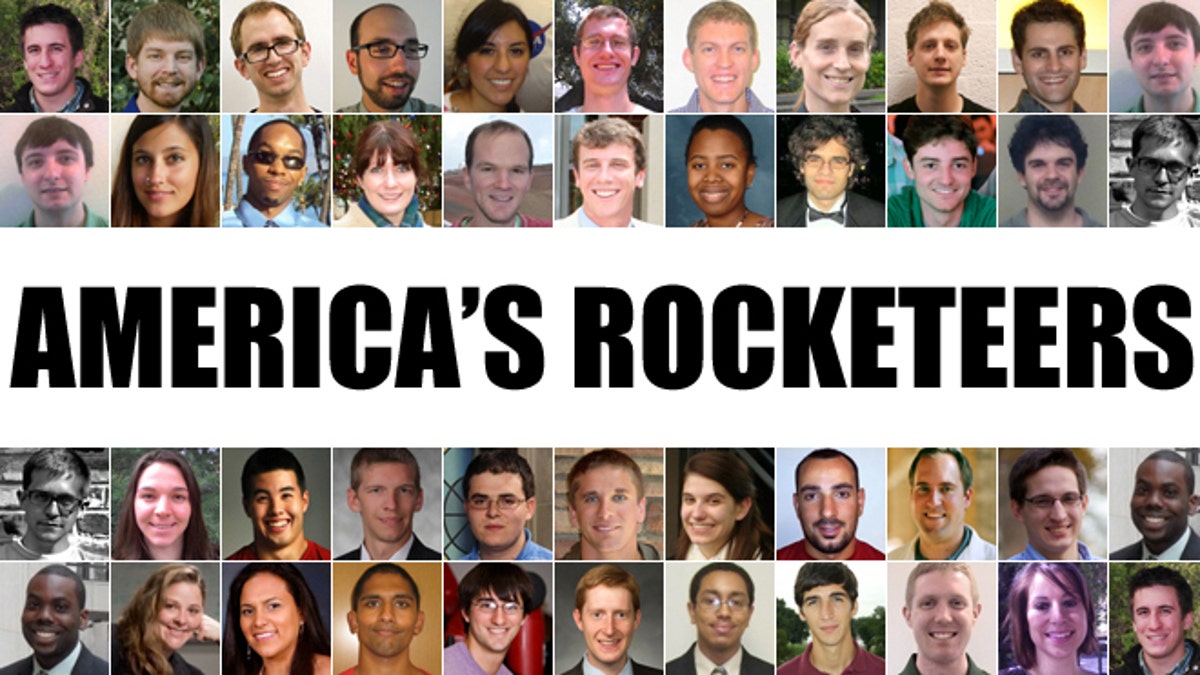
NASA recently selected 65 graduate students as the 2013 class of Space Technology Research Fellows -- their research could help advance the space agency's roadmap. (NASA)
Fresh ideas from young rocket scientists of the millennial generation might just kick-start the U.S. space program -- just as similarly young scientists did in the 1960s' race to the moon.
Rocketeers like 24-year-old Cory Medina are inventing new ways to explore space. A design engineer at NASA’s Marshall Space Flight Center in Huntsville, Ala., he’s using 3D printed parts (also known as additive manufacturing) to design a combustion chamber for a new 35,000-pound thrust liquid rocket engine. The idea is to launch multiple low-cost “cube” satellites created using 3D printed materials.
Another example: Neelanjan Bandyopadhyay is a 29-year-old Ph.D. student at Northwestern University. He’s working on something called a quantum cascade laser. Current lasers used to look for life on Mars are too big and bulky, so Bandyopadhyay has developed a laser that is more portable and yet powerful enough to make the search more feasible.
“I've developed high-power lasers below 4 microns to as short as 3 microns,” he told FoxNews.com. “Right now, interband cascade lasers are in use on the Mars Rovers. However, our lasers can have much higher power due to cascading of many repetitions of the same active region ... and can detect hydrocarbons with greater sensitivity.”
By focusing on one particularly important wavelength of light that is strongly absorbed by methane, he’s improving the hunt for life.
- Farmer stumbles across 2,000-year-old sarcophagus while planting coffee in Bali
- 123456?? Adobe hack highlights crummy passwords
- China’s Forbidden City built with giant ‘sliding stones’
- Western Digital unveils 6TB, helium-filled hard drive
- Mummy’s colorful collar found in Egyptian tomb
- Lockheed Martin’s Skunkworks to build successor to SR-71 Blackbird
"Finding methane, the simplest hydrocarbon, in sufficient quantity, should indicate the possibility of more complex organic compounds for life," Bandyopadhyay said.
India on Tuesday launched its first Mars exploration rocket and China has in recent years poured millions into its space program. Citing space policy experts, The Houston Chronicle wrote that the government must step up NASA funding to retain a leadership position.
While there are no signs we’re ready to go back to the moon today, let alone send someone to Mars, some of these bright ideas might help get us there someday.
Sam Rodkey is a propulsion engineer at Blue Origin, the space tech company funded by Jeff Bezos from Amazon. Rodkey is designing new lower-cost rocket technology to compete with NASA. At SpaceX, young rocketeers like Kevin Miller and John Tsohas are also working on next-gen rocket technology. All are recent graduates from Purdue University in Indiana.
What’s fueling these young rocketeers? It’s partly a new funding effort from the U.S. government. In late September, NASA announced the winners of the Space Technology Research Grants Program to help universities invent new ideas. Some of the projects, which each receive $250,000, include an oxygen recovery system, a study of cryogenic fuel for deep-space voyages, and a way to detect asteroids in space using image recognition technology.
"A critical element of America's space technology pipeline rests in the cutting edge research in the early stage technologies conducted at the nation's universities," said Michael Gazarik, NASA's associate administrator for space technology, in a statement. "Through this investment NASA will continue to benefit from university-led R and D."
Last year, DARPA awarded the SpaceGAMBIT program a $500,000 grant to build a hackerspace for young rocketeers. So far, one of the proposals includes a self-sustaining biosphere habitat, a new spacesuit, and a low-cost bioreactor that can grow organisms in space.
“Exploring and living for extended periods in space will require advances on many, many technologies, especially life support systems,” Jerry Isdale, the SpaceGAMBIT program lead, told FoxNews.com. “We can now quickly prototype systems on Earth, refining the designs based on real world usage so the technology will be ready for use off planet.”
Of course, there’s a big difference between these ideas from young adults of today and those that helped start the space program originally. Their work is not nearly as glamorous -- many of these rocketeering programs involve lab work to design new laser systems or methods to communicate in space without as much interference.
But they could help us reach Mars or even beyond our solar system in the next 10-20 years.
Here’s hoping.
